November 2025
The global paraxylene market volume was reached at 62.60 million Tons in 2024 and is expected to hit around 96.40 million Tons by 2034, exhibiting a compound annual growth rate (CAGR) of 4.59% during the forecast period 2025 to 2034. The sudden expansion of the polystyrene industry and sustainable practices is accelerating industry potential in the current period.
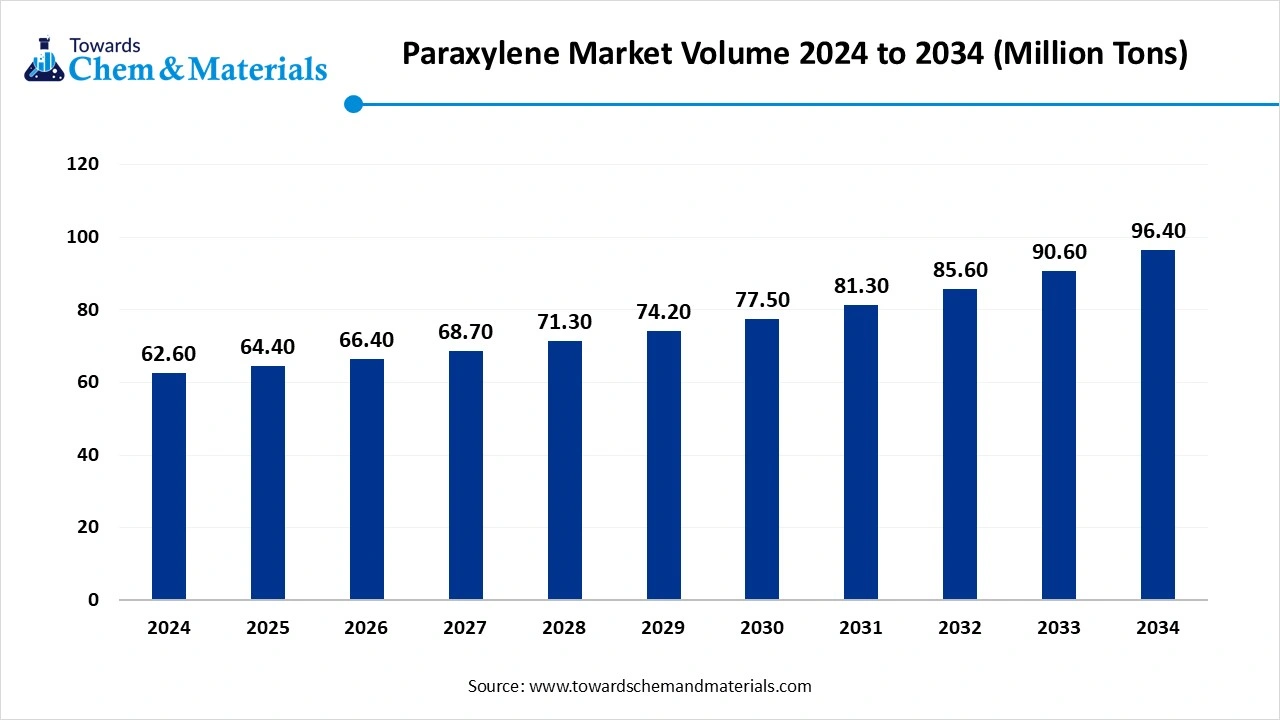
The paraxylene market is experiencing fast-paced growth, primarily driven by its critical role in the production of purified terephthalic acid (PTA), which is increasing the market momentum in the polyester value chain. With rising global demand for polyester-based products in textiles and packaging, paraxylene consumption continues to increase, which can create greater opportunities for manufacturers. Also, regions like Asia-Pacific remain the dominant region due to their extensive manufacturing base and high polyester output in the current period.
Moreover, growing urbanization, lifestyle changes, and increased consumption of ready-to-wear apparel and bottled beverages are seen as fueling demand for paraxylene in recent years. The global shift toward lightweight, durable materials for consumer goods and industrial use also supports market expansion. Also, refinery integration and capacity expansions are becoming more common, as manufacturers are aiming to optimize margins and meet regional demand shifts. As sustainability becomes a central focus, the market is also witnessing several
The increasing global demand for polyester, especially in the textile and packaging sectors, is expanding the paraxylene market potential in the current period. Also, paraxylene is considered a crucial component to produce PTA, which is then used to manufacture polyethylene terephthalate (PET), a key component in fabrics, bottles, and food packaging. The growing consumption of modern fashion and the expansion of e-commerce have led to an increase in polyester usage, particularly in developing economies in the current period. Furthermore, the global beverage industry’s rising use of PET bottles continues to push paraxylene demand higher, which has contributed to market growth recently.
This strong consumption has encouraged major players to increase paraxylene production capacity and streamline operations while maintaining supply stability. Moreover, the sudden shift toward recycling and sustainable packaging is influencing investment in more efficient production technologies, as per the observation.
| Report Attributes | Details |
| Market Volume in 2025 | 64.40 Million Tons |
| Expected Volume by 2034 | 96.40 Million Tons |
| Growth Rate from 2025 to 2034 | CAGR 4.59% |
| Base Year of Estimation | 2024 |
| Forecast Period | 2025-2034 |
| High Impact Region | Asia Pacific |
| Segment Covered | By Application, By Region |
| Key Companies Profiled |
Sinopec, JX Nippon Oil & Energy Corp, CNPC, Reliance, NPC Iran, GS Caltex, ONGC, Orpic, Oman Oil Refineries, and Petroleum Industries Company, Jurong Aromatics Corp, China National Offshore Oil Corporation (CNOOC), Lotte KP Chemical, ExxonMobil,Saudi Aramco, Dalian Fujia Dahua, Idemitsu Kosan Co.Ltd.,Toyo, Teijin Fibers |
The rising demand for polyethylene terephthalate (PET) across the packaging and textile industries is expected to create significant opportunities for paraxylene market during the forecast period. With increasing consumer preference for lightweight and recyclable packaging, paraxylene becomes a critical raw material. Manufacturers are seen in increasing production lines and optimizing processes to meet the rising PET requirements in the current period. As sustainability gains potential, several industries are seeking efficient supply chains, giving paraxylene
Paraxylene production is heavily dependent on crude oil-derived raw materials, which are anticipated to hinder industry growth during the forecast period. As a result, fluctuations in global crude oil prices pose a significant challenge for manufacturers in the future. These price shifts can impact profit margins, disrupt costing, and make long-term planning more complex as per market observation. But also, companies are seeking alternative source strategies and improved cost management techniques in the current period, which gives them an industry
The purified terephthalic acid (PTA) segment dominated the paraxylene market with the largest share in 2024, akin to its key role as a primary raw material to produce polyester fibers, films, and resins is driving the segment growth in the current period. Moreover, the demand for PTA has surged across industries, especially textiles and packaging, where it is used to manufacture high-strength materials. The rising need for sustainable products and the increasing consumption of polyester in emerging markets further fuel the growth of the PTA segment during the forecast period.
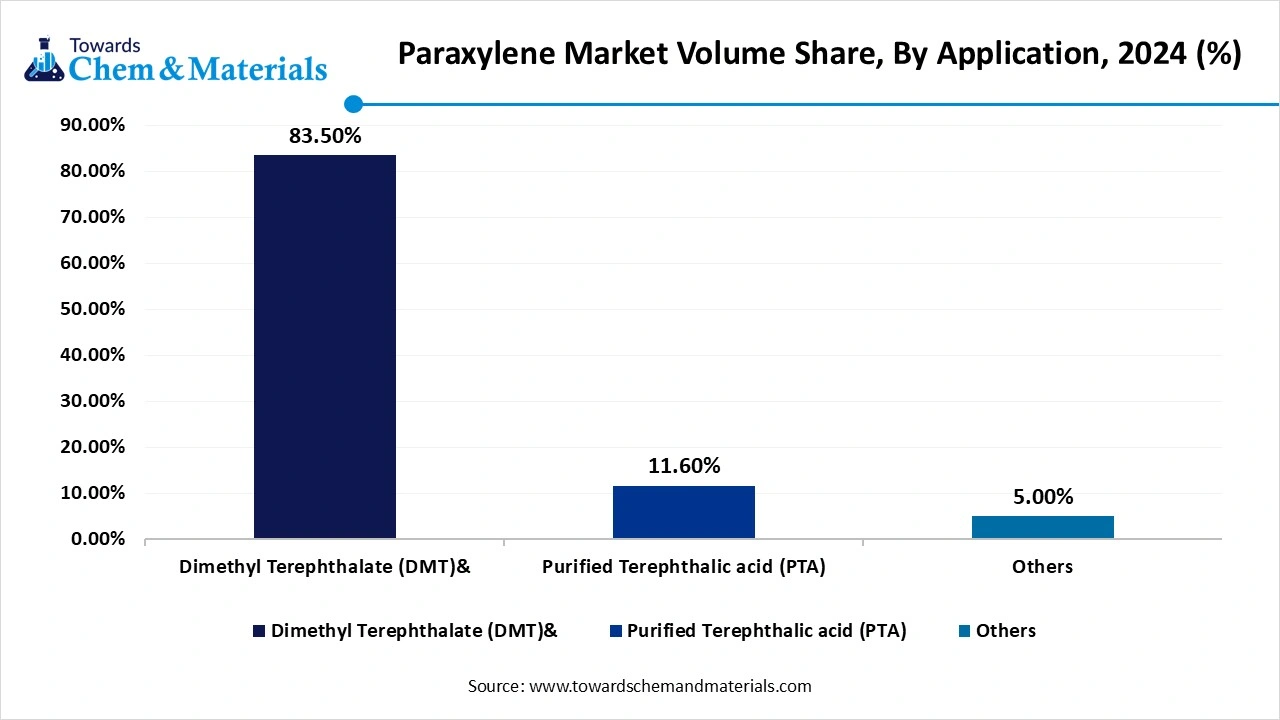
The dimethyl terephthalate (DMT) segment is expected to experience notable market growth in the future, owing to its widespread use in the production of polyester, especially for bottles and packaging materials. Also, as global demand for lightweight, cost-effective packaging solutions grows, dimethyl terephthalate’s role in producing high-quality, durable polyester increases, which is expected to create huge opportunities for manufacturers in the coming years. Moreover, dimethyl terephthalate's versatility in various applications, such as in the automotive and textile industries, drives further growth, making it a key driver of market expansion in the coming years.
Paraxylene Market Volume Share, By Application, 2024 & 2034 (%)
| By Application | Market Shares (%) 2024 | Volume (Million Tons) 2024 | Market Shares (%) 2034 | Volume (Million Tons) 2034 | CAGR (2025-2034) |
| Dimethyl Terephthalate (DMT) | 83.50% | 52.20 | 81.60% | 78.60 | 4.70% |
| Purified Terephthalic acid (PTA) | 11.60% | 7.30 | 13.40% | 12.90 | 6.60% |
| Others | 5.0% | 3.10 | 5.0% | 4.90 | 5.10% |
The Asia Pacific paraxylene market volume was valued at 42.10 million tons in 2024 and is expected to be worth around 64.96 million tons by 2034, exhibiting at a compound annual growth rate (CAGR) of 4.40% over the forecast period 2025 to 2034, akin to its strong demand from the polyester and textile industries, particularly in countries like India, South Korea, and Japan. The region’s integrated petrochemical infrastructure and expanding production capacities support efficient large-scale output in the region. Also, rising consumer need for packaged goods and textiles continues to drive the growth of the regional industry in the current period. Moreover, regional governments are seen as supporting industrial development through favorable policies and investments in recent years. As a result, manufacturers are increasing operations and optimizing supply chains to meet rising domestic and export needs in the region nowadays.
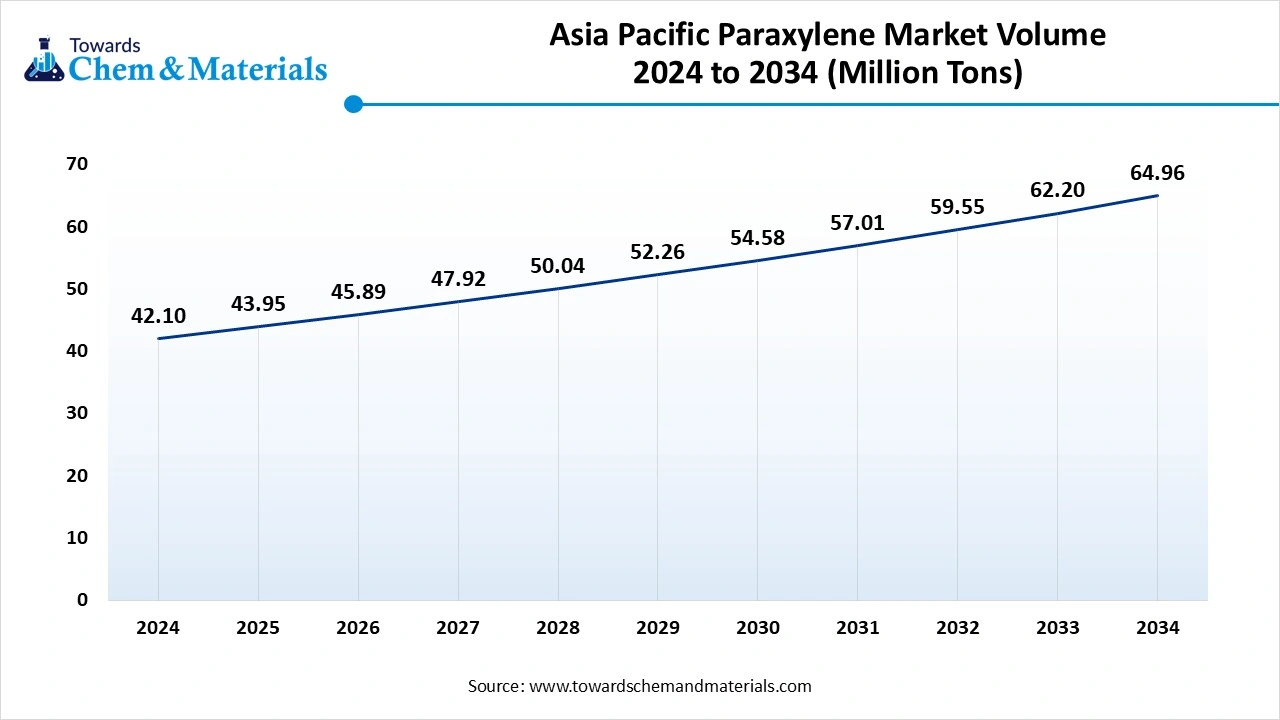
China Sets the Pace in Global Paraxylene Production, China maintained its dominance owing to its enlarged polyester industry and domestic consumption. Also, it is the world's largest producer and consumer of paraxylene, with continued investments in new production facilities to reduce dependency on imports in the current period. From the other regional countries, China’s enterprises and industrial zones allow for rapid capacity expansion in the future. Moreover, the country’s planning and focus on self-sufficiency in petrochemicals further create growth opportunities for the manufacturers in the
North America is expected to grow at a significant pace in the coming period, akin to advancements in shale gas extraction, offering cost-effective feedstock for petrochemical production in the current period. The region can receive greater advantages from technological innovation, robust refining infrastructure, and a focus on enhancing energy efficiency in the future. As global supply chains shift, North American producers are expanding capacities to fulfill both domestic and export markets. Moreover, sustainable production practices and increasing demand for recycled PET are also expected to increase industry potential during the forecast period. Strategic investments and favorable trade dynamics are reshaping the
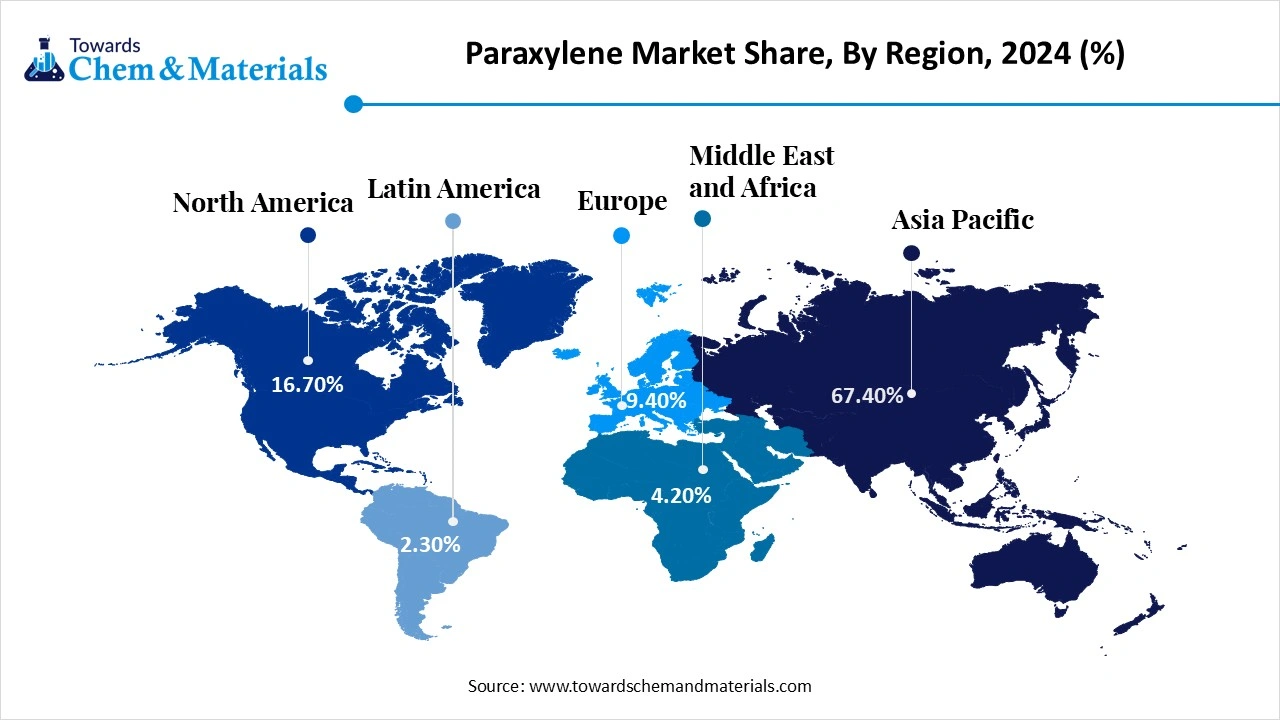
Energy Efficiency and Raw Material Access Supports Paraxylene Growth in United States, The United States paraxylene market is experiencing notable growth owing to its integrated petrochemical ecosystem and strong technological base. United States producers are receiving the advantages from shale-based raw materials and cost-effective energy, enhancing production efficiency in the current period. While the enlarged region is export-driven, the United States is focused on capacity expansion and innovation in processing technologies, which is expected to increase industry growth in the coming years. Also, domestic demand is supported by robust end-use industries like automotive, construction, and textiles. Moreover, regulatory support and infrastructure modernization are seen in allowing faster project execution in the execution in the country nowadays.
Paraxylene Market Volume Share, By Region, 2024 & 2034 (%)
| By Region | Market volume Shares (%) 2024 | Market Volume (Million Tons)2024 | Market volume Shares (%) 2034 | Market Volume (Million Tons) 2034 | CAGR (2025-2034) |
| North America | 16.70% | 10.50 | 18.20% | 17.50 | 5.90% |
| Europe | 9.40% | 5.90 | 9.80% | 9.40 | 5.40% |
| Asia Pacific | 67.40% | 42.10 | 64.40% | 62.0 | 4.40% |
| Latin America | 2.30% | 1.40 | 2.60% | 2.50 | 6.30% |
| Middle East & Africa | 4.20% | 2.60 | 5.0% | 4.80 | 7.0% |
Indorama and Suntory
Fujian Petrochemical Co. Ltd., Saudi Arabian Oil Co., and China Petroleum & Chemical Corp.
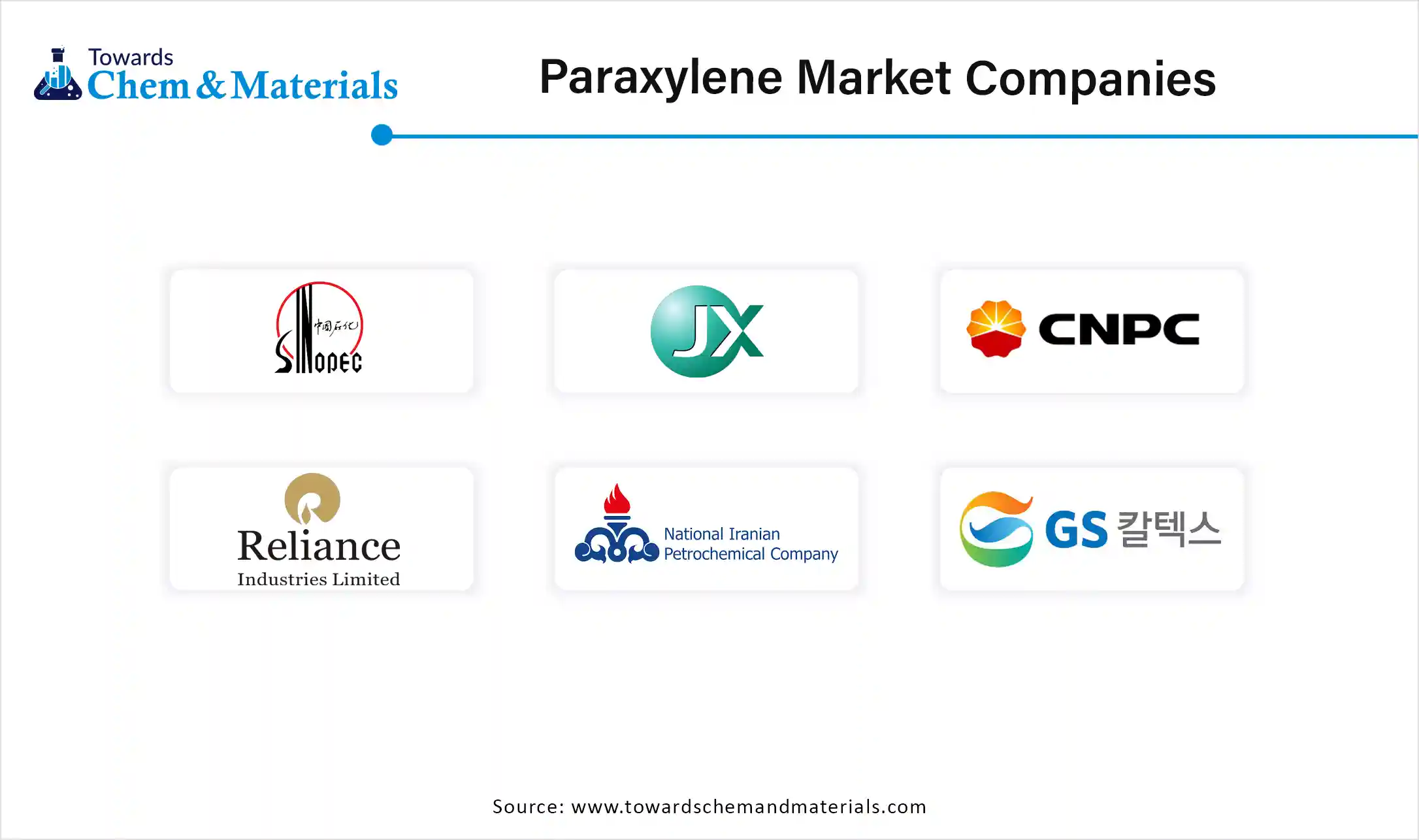
By Application
By Region
The global silica for s-sbr market size was accounted for USD 2.57 billion in 2024 and is expected to be worth around USD 4.50 billion by 2034, growin...
According to the new research report, the global heat treating market size was valued at USD 110.98 billion in 2024, grew to USD 115.14 billion in 202...
The latest market outlook reports that, the global nafion market size is expected to be worth around USD 3.96 billion by 2034 from USD 2.19 billion in...
November 2025
November 2025
November 2025
November 2025